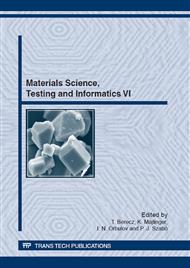[1]
ASTM E 399, Standard Test Method for Linear-Elastic Plane-Strain Fracture Toughness KIc of Metallic Materials, (2006).
DOI: 10.1520/e0399-08
Google Scholar
[2]
S. K. Nath, U. Kr. Das, Effect of microstructure and notches on the fracture toughness of medium carbon steel, Journal of Naval Architecture and Marine Engineering. 3 (2006) 15-22.
DOI: 10.3329/jname.v3i1.925
Google Scholar
[3]
M. Haager, G. Pinter, R. W. Lang, Ranking of PE-HD pipe grades by fatigue crack growth performance, Plastics Pipes XIII, Washington, 2006. pp.1-11.
DOI: 10.1179/174328905x29758
Google Scholar
[4]
Sz. E. Kovcsik, E. M. Morozov, Kharakterisztiki kratkovremennojj treshhinosztojjkoszti materialov i metodü ikh opredelenija, Kiev, Naukova Dumka, (1988).
Google Scholar
[5]
O. N. Romaniv, G. N. Nikiforcsin, Mekhanika korrozionnovo razrushenija konsztrukcionnükh szplavov, Moszkva, Metallurgija, (1986).
Google Scholar
[6]
F. Nilsson, Fracture Mechanics – from Theory to Applications, KTH Högskoletryckeriet, Stockholm, (1999).
Google Scholar
[7]
P. Romvári, L. Tóth, J. Lukács, Rechnergestützte Lebensdauerabschätzung unter Anwendung der Bruchmechanik, Neue Hütte. 30 (1985) 103-105.
Google Scholar
[8]
J. Lukács, Effect of Reliability of Crack Propagation Measurement on the Assessment of Life-Times for Structural Elements Having Flaws, The International Journal of Pressure Vessels and Piping. 55 (1993) 261-268.
DOI: 10.1016/0308-0161(93)90034-q
Google Scholar
[9]
E. Y. Lim et al., Approximate influence functions for part-circumferential interior surface cracks in pipes, in: ASTM STP 791, American Society for Testing and Materials, 1983, pp. I281-I296.
Google Scholar
[10]
J. C. Jr. Newman, I. S. Raju, Stress intensity factors for internal surface cracks in cylindrical pressure vessels, Journal of Pressure Vessel Technology, Transactions of the ASME. 102 (1980) 342-346.
DOI: 10.1115/1.3263343
Google Scholar
[11]
H. P. Keller (Ed. ), Bruchmechanik druckbeanspruchter Bauteile, Carl Hanser Verlag/Verlag TÜV Rheinland, München-Wien-Hauser-Köln, (1990).
DOI: 10.1002/mawe.19920230309
Google Scholar
[12]
J. C. Jr. Newman, I. S. Raju, Stress intensity factors for internal and external surface cracks in cylindrical vessels, Journal of Pressure Vessel Technology, Transactions of the ASME. 104 (1982) 293-298.
DOI: 10.1115/1.3264220
Google Scholar


